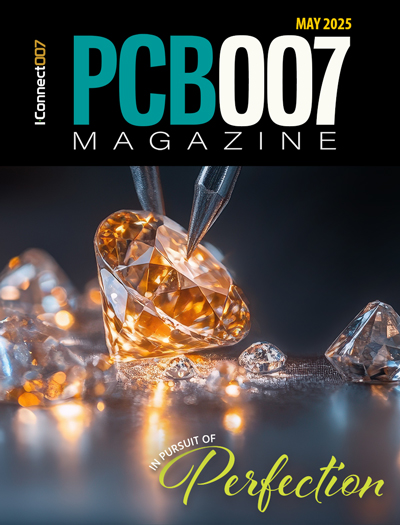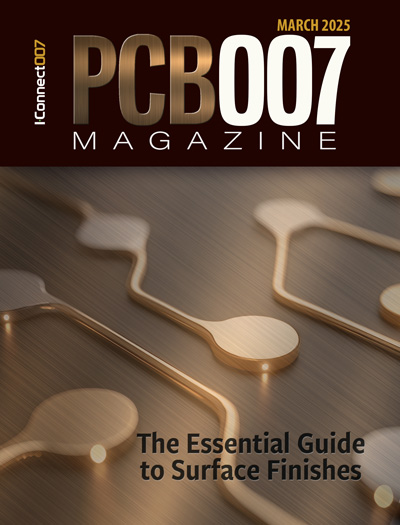-

- News
- Books
Featured Books
- pcb007 Magazine
Latest Issues
Current Issue
In Pursuit of Perfection: Defect Reduction
For bare PCB board fabrication, defect reduction is a critical aspect of a company's bottom line profitability. In this issue, we examine how imaging, etching, and plating processes can provide information and insight into reducing defects and increasing yields.

Voices of the Industry
We take the pulse of the PCB industry by sharing insights from leading fabricators and suppliers in this month's issue. We've gathered their thoughts on the new U.S. administration, spending, the war in Ukraine, and their most pressing needs. It’s an eye-opening and enlightening look behind the curtain.

The Essential Guide to Surface Finishes
We go back to basics this month with a recount of a little history, and look forward to addressing the many challenges that high density, high frequency, adhesion, SI, and corrosion concerns for harsh environments bring to the fore. We compare and contrast surface finishes by type and application, take a hard look at the many iterations of gold plating, and address palladium as a surface finish.
- Articles
- Columns
Search Console
- Links
- Media kit
||| MENU - pcb007 Magazine
Chemical Legislation and Restrictions on Solder Masks
April 27, 2023 | Chris Wall, technical director, Electra PolymersEstimated reading time: 5 minutes
Ever since liquid photoimageable solder masks (LPISMs) were introduced, their UV exposure speed has been a key factor in their performance. The LPISM is coated onto the PCB, dried, and then selectively exposed with UV light via a phototool, or more recently, via direct imaging using LED or lasers. The exposed areas polymerise and become insoluble in the developing solution. The polymerisation is initiated by one or more chemicals called photoinitiators, which are components of the LPISM.
After development, during final cure, other components react thermally to give the finished solder mask properties.
REACH
REACH (Registration, Evaluation, Authorisation, and Restriction of Chemicals) is a European Union regulation that was adopted in 2006 and came into force in 2007.
Under REACH, manufacturers and importers of chemicals must register the substances they produce or place on the market in Europe with the European Chemicals Agency (ECHA). The registration process requires manufacturers and importers to provide information on the properties, uses, and potential risks of the substances they produce or import. Generally, REACH applies to all individual chemical substances on their own, in mixtures, or in articles. However, some aspects of REACH only apply to quantities of one tonne/year or more.
The REACH regulation establishes a process for identifying and controlling substances of very high concern (SVHCs). As part of this process, the European Chemicals Agency (ECHA) maintains a list of substances that are being evaluated for potential inclusion in Annex XIV (the “Authorization list”), called the Candidate List of Substances of Very High Concern (SVHCs).
UK REACH
In the UK, the government created UK REACH, which adopted all the provisions of REACH as they were at the time of Brexit. Under the European Union (Withdrawal) Act 2018, the EU REACH Regulation was brought into UK law on Jan. 1, 2021, and is known as UK REACH. EU REACH, and related legislation, were replicated in the UK with the changes needed to make it operable in a domestic context.
The REACH statutory instruments that made these changes can be found on legislation.gov.uk.
The key principles of the EU REACH Regulation were retained in UK REACH, which regulates chemicals placed on the market in GB. The UK REACH and the EU REACH regulations operate independently from each other. You must ensure you comply with both regulations, where necessary.
Candidate List
The Candidate List includes substances that have been identified as having properties such as being:
- Carcinogenic, mutagenic, toxic to reproduction (collectively termed CMR)
- Persistent, bioaccumulative and toxic (PBT)
- Very persistent and very bioaccumulative (vPvB) or that are considered to be of equivalent concern
After a substance is added to the Candidate List, ECHA evaluates it based on the data submitted and potentially renders a decision on the proposed restrictions or authorisation requirement. After completion of this evaluation, the proposed restriction or authorisation requirement is brought forward at the REACH Committee, where representatives from Member States and European Commission decide whether to adopt the measure.
Once a substance is added to the Candidate List, manufacturers and importers of “articles,” such as PCBs, are required to provide information to their customers and downstream users about the presence of the substance in their products, if the substance is present above 0.1 weight% (of the whole article).
Annex XIV (the “Authorization list”)
Once a substance is added to the Candidate List, it means that it is being considered for inclusion in the "Authorization List” which lists those substances that can only be used under specific conditions, such as that the risks are adequately controlled.
Table 1: Draft 11th Recommendation of Priority Substances.
Once a substance has been added to the Authorisation List, there will be a period of 18, 21, or 24 months from the date of inclusion for manufacturers or importers to apply for authorisation to continue manufacture or import of the substance the latest application date (LAD). If this is granted, it will be authorised for use for a further period. At the same time, a sunset date (SD) will be notified, which is 18 months after the LAD. This is the date after which the substance can no longer be used or placed on the market without an authorisation. A candidate list is included1.
Registry of SVHC Intentions Until Outcome
Member States (or ECHA at the request of the European Commission), may propose a substance to be identified as a Substance of Very High Concern (SVHC) by preparing a dossier in accordance with the requirements set out in Annex XV to REACH. An evaluation process is included2.
The Registry of SVHC Intentions until Outcome aims to make interested parties aware of the substances for which an SVHC dossier is planned to be submitted to ECHA.
Photoinitiators subject to, or likely to become subject to, usage restrictions:
- 907: (2-methyl-1-(4-methylthiophenyl)-2-morpholinopropan-1-one)
This photoinitiator, when combined with one or more other photoinitiators, gives exceptional photospeed. For this reason, it has been used by manufacturers of LPISMs all over the world, however, it has been on the Candidate List since 2020 and has recently been prioritised for inclusion in the Authorisation List.
- 369: (2-benzyl-2-dimethylamino-4'-morpholinobutyrophenone)
This photoinitiator was introduced previously as a potential replacement for 907 but is now grouped with 907 for inclusion in the Authorisation List.
Other components of solder masks subject to, or likely to become subject to, usage restrictions:
- TGIC (1,3,5-tris(oxiranylmethyl)-1,3,5-triazine-2,4,6(1H,3H,5H)-trione)
A thermal curing agent used in soldermask hardeners; added to Candidate List 18-Jun-2012
- Melamine (1,3,5-triazine-2,4,6-triamine)
Thermal curing agent; added to Candidate List 17-Jan-2023
- TPO (Diphenyl(2,4,6-trimethylbenzoyl)phosphine oxide
Photoinitiator; recently added to the Registry of SVHC intentions until outcome
Timeline for Permitted Use of 907 and 369
For 907 and 369, if no authorisation is obtained, they will no longer be authorised for use 36 to 42 months after they are added to Annex XIV.
Status of 907 in Electra Products
In preparation for this date, Electra has been working hard to develop LPISM products of equivalent performance which do not contain 907. These materials are available for evaluation through your local contact.
Action Required
To date, nothing has changed with regard to the obligations of solder mask users with respect to 907. The substance has been on the Candidate list since 2020 and PCB manufacturers should already be notifying their customers of its presence (if appropriate) in the boards they supply to their customers.
If they are not and they are uncertain if the solder mask they use contains it, they should contact their solder mask supplier and ask for confirmation. If the solder mask is being imported from outside the EU (and/or UK) they should also ask for confirmation that all the component substances are registered under REACH (and UK REACH).
Looking forward, solder mask users may wish to consider looking at solder mask products which do not contain 907 and they should contact their solder mask suppliers for alternatives.
References
- Preparation of Draft Annext XIV Entries for Substances Recommended to be Included in Annex XIV, European Chemicals Agency, echa.europa.eu.
- Substances of Very High Concern, echa.europa.eu.
Chris Wall is technical director at Electra Polymers.
Suggested Items
Preventing Surface Prep Defects and Ensuring Reliability
06/10/2025 | Marcy LaRont, PCB007 MagazineIn printed circuit board (PCB) fabrication, surface preparation is a critical process that ensures strong adhesion, reliable plating, and long-term product performance. Without proper surface treatment, manufacturers may encounter defects such as delamination, poor solder mask adhesion, and plating failures. This article examines key surface preparation techniques, common defects resulting from improper processes, and real-world case studies that illustrate best practices.
Breaking Silos with Intelligence: Connectivity of Component-level Data Across the SMT Line
06/09/2025 | Dr. Eyal Weiss, CybordAs the complexity and demands of electronics manufacturing continue to rise, the smart factory is no longer a distant vision; it has become a necessity. While machine connectivity and line-level data integration have gained traction in recent years, one of the most overlooked opportunities lies in the component itself. Specifically, in the data captured just milliseconds before a component is placed onto the PCB, which often goes unexamined and is permanently lost once reflow begins.
BEST Inc. Introduces StikNPeel Rework Stencil for Fast, Simple and Reliable Solder Paste Printing
06/02/2025 | BEST Inc.BEST Inc., a leader in electronic component rework services, training, and products is pleased to introduce StikNPeel™ rework stencils. This innovative product is designed for printing solder paste for placement of gull wing devices such as quad flat packs (QFPs) or bottom terminated components.
See TopLine’s Next Gen Braided Solder Column Technology at SPACE TECH EXPO 2025
05/28/2025 | TopLineAerospace and Defense applications in demanding environments have a solution now in TopLine’s Braided Solder Columns, which can withstand the rigors of deep space cold and cryogenic environments.
INEMI Interim Report: Interconnection Modeling and Simulation Results for Low-Temp Materials in First-Level Interconnect
05/30/2025 | iNEMIOne of the greatest challenges of integrating different types of silicon, memory, and other extended processing units (XPUs) in a single package is in attaching these various types of chips in a reliable way.


